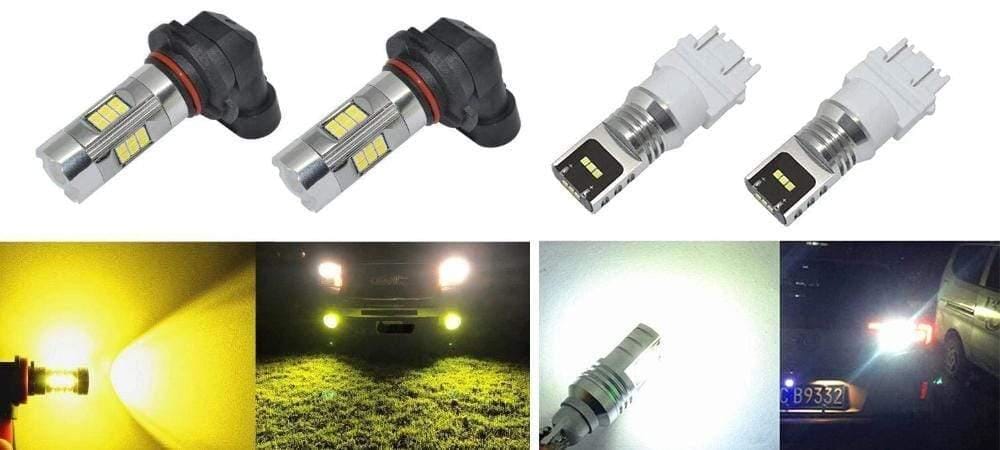Like many car, truck, and sport utility vehicle(SUV) owners across the country and around the world, you may be highly interested in converting different lights on your vehicle with light-emitting diode (LED) bulbs. This may include the replacement of LED headlights, LED taillights, LED fog lights, and a full spectrum of LED lights for the interior. With that noted, there are a number of important facts and factors to bear in mind when it comes to converting to LED lights.
LED Lights Are the Future of Vehicle Illumination
If you are like many people, you're interested in being up-to-date with the latest and greatest technology. The fact is that LED lights represent the future of vehicle illumination. With each passing year, not only are an ever-increasing number of motor vehicle owners switching out their traditional lighting equipment to LED options but manufacturers are more frequently building vehicles with LED lights as standard equipment. This trend certainly is expected to continue into the future.
Due to the manner in which LED lights are designed and manufactured, they create significantly more illumination output per watt than do their traditional incandescent bulb counterparts. Perhaps more significantly, LED light accomplishes this important objective by using what amounts to only a fraction of the electrical draw associated with traditional incandescent alternatives.
Moreover, LED lights do not waste power creating unnecessary heat energy. As a consequence, LED lights are relatively cool to the touch in nearly all situations.
Finally, unlike traditional incandescent bulbs, LED lights have no filament that ends up consumed during use. The net effect of this feature is that LED lights have substantially longer lifespans that most incandescent bulbs traditionally found incorporated into motor vehicles.
You Can Select the LED Light Bulb Color that Meets Your Needs and Desires
Another consideration to bear in mind when it comes to selecting LED light bulbs for your car is color. The color decision is easier when it comes to LED headlights, LED fog lights, and LED taillights. When it comes to exterior colors for LED bulbs, the selected light must coordinate with the color of the lens. You must select exterior LED light bulbs that meet the specific legal requirements of the state in which the vehicle is registered. For example, LED bulbs for tail lights must be white or red in order to harmonize with the color of a tail light lens.
You have tremendous flexibility when it comes to the colors of LED lights for the interior of your vehicle. LED interior lights come in a wide range of color options:
- White
- Amber
- Blue
- Green
- Pink
- Purple
- Red
- Yellow
- Multicolor
You Can Convert Your Headlight Bulbs to LED with Plug-and-Play Bulbs
You may wonder whether there are any LED headlight conversion problems. You may wonder whether there can be issues with other types of LED bulb conversions. The reality is that most conversion kits feature relatively easy-to-use plug-and-play bulbs. This includes h4(high output) LED bulb conversion kits.
The reality is that there is a considerable array of different types of LED replacement kits that feature plug-and-play bulbs:
- Headlights
- Tail lights
- Brake lights
- Side marker lights
- Turn signal lights
- Fog lights
- Daytime running lights
- Reverse lights
These types of kits are compatible with more than just recently-built vehicles. In fact, virtually any car or truck manufactured in the past 50 years is capable of being refitted with plug-and-play LED replacement bulbs.
Turn Signals May Require Resistors for LED Replacement Bulbs
You do need to make a special note about turn signal LED replacement bulbs. If you intend to replace your front and rear turn signal bulbs to LED derivations, bear in mind that many vehicles have what is known as a flasher unit. The flasher unit is designed to work with traditional incandescent bulbs.
As a consequence, an issue may arise when the objective is to replace traditional incandescent turn signal bulbs with LED alternatives. Without a resistor (a specialized adapter), replacing a traditional bulb with an LED one can result in turn signal lights flashing far too rapidly. This condition is called “hyper flashing.” The flasher unit might interpret this hyper flashing as being a burned-out bulb, when that technically is not the case.
Hyper flashing can be avoided by obtaining a set of relatively easy to install resistors. In very basic terms, resistors fool the flasher unit so that the unit doesn't interpret hyper flashing as a bulb failure or burned out bulb.
A resistor creates the proper amount of resistance. This action results in the front and back turn signals flashing at the correct or proper rate.
Invest Now in LED Lights for Your Vehicle
While LED lights generally do cost more than traditional incandescent alternatives, paying a bit more for this type of lighting nearly always proves to be a cost-saving investment in the long run. Because LED lights have a longer lifespan than incandescent bulbs, they need replacement with significant less frequency than traditional alternatives.
Indeed, if you end up owning your vehicle the average length of time a person keeps a car, truck, or SUV, odds are strong that you may never reach the day in which the replacement of LED lights become an option. This is the case with factory-installed bulbs as well as replacement LED bulbs.
If you're contemplating giving your vehicle an upgrade, replacing traditional light bulbs on and in your ride is a great way of enhancing your car, truck, or SUV on many levels. Through LED bulbs, you can improve the overall illumination associated with your vehicle. You can enhance your vehicle's looks and save money in the long term.

